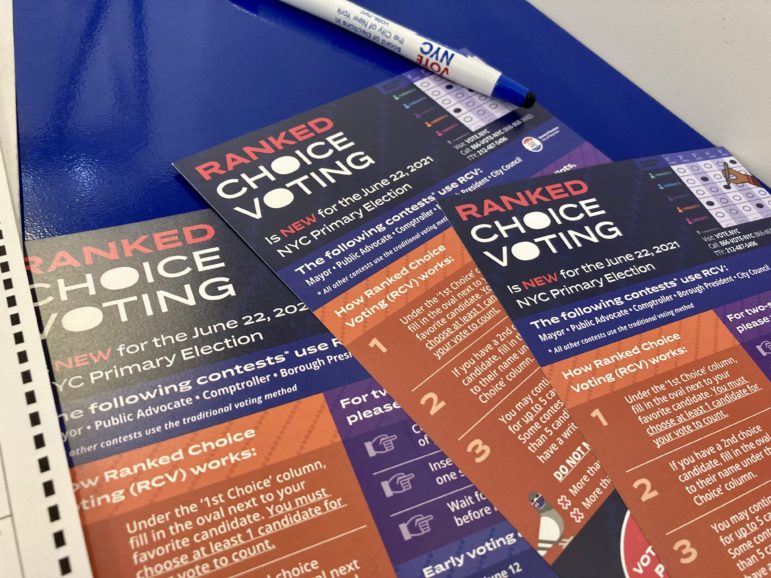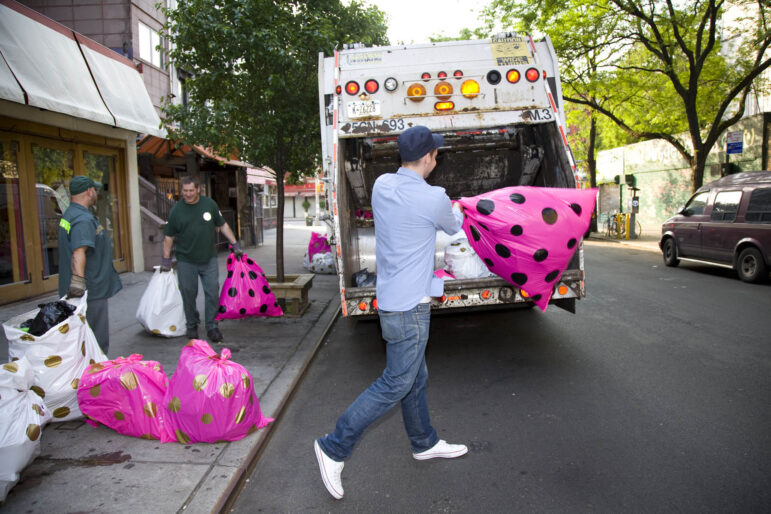The City Council, where only 14 women serve in a chamber of 51, is poised—for the first time—to become a majority female body with 29 women currently leading in their respective races.’

Jeanmarie Evelly
Handouts explaining the new Ranked Choice Voting (RCV) system.This election season has been eventful, to say the least. But amidst all of the madness, I want to remind New Yorkers of something important, something that we’re not talking about enough. No matter what the final results are, for the first time ever, our local government might actually reflect the lived experience of this city of 8.5 million that’s more than 50 percent women, and more than 50 percent people of color.
New York is one of the most diverse cities in the world, but we’ve traditionally fallen short in terms of representation. Not anymore.
The City Council, where only 14 women serve in a chamber of 51, is poised—for the first time—to become a majority female body with 29 women currently leading in their respective races. And 86 percent of them are women of color. We need this—especially after COVID-19 made clear all of the ways that women, and especially women of color, are at a disadvantage.
It’s not just the City Council. Out of 109 mayors of New York, 108 have been white men. But our next mayor will either be a Black man, a white woman, or a Black woman like me. No matter what happens, that simple fact is historic. Descriptive representation is only one factor that matters to me among many. But that doesn’t change why I’m excited about our current frontrunners.
We have ranked choice voting, and the incredible work from groups like 21 in ‘21 and Women of Color for Progress, to thank for this surge in representation.
 CityViews are readers’ opinions, not those of City Limits. Add your voice today!
CityViews are readers’ opinions, not those of City Limits. Add your voice today!
Research shows that ranked choice voting results in more wins for candidates of color, especially women. For one, it’s easier for women to run in ranked choice voting elections. When candidates are gunning for second and third rankings in addition to firsts, there’s an incentive toward more positive, issue-based campaigning. Evidence suggests that women are more likely to run in a positive campaign environment without attack ads and with more focus on substance. And more of them can run for the same seat because ranked choice voting eliminates vote splitting. This means voters who choose to prioritize women on their ballots could cast their votes for all of the women running for their district’s City Council seats. The proof is in the results.
Yes, the Board of Elections’ mistake last week was unacceptable. New Yorkers deserve election administrators who are competent, thorough, and don’t let anything slip through the cracks. Board of Elections reform is an urgent issue—but those who are claiming that this has anything to do with ranked choice voting are knowingly misleading the public. It was human error, plain and simple. Remember: even without these shenanigans, we still wouldn’t have the final results yet. Absentee ballots are only now being counted—per pro-voter reforms written into state law—and we can expect the final results the week of July 12. For contrast, just look at the Manhattan District Attorney’s race, where they don’t have ranked choice voting but they’re still subject to the same timeline to account for absentee ballots. So instead of spending $15 million on a costly run-off election where only a third of those who voted would show up again, we’re making sure that 1.1 million New Yorkers who voted this June have a say.
Ranked choice voting is good for New York. That’s why 74 percent of voters approved it in 2019, and in exit polling conducted during early voting and on primary day this year, 77 percent of New Yorkers said they’d like to continue ranking their votes. Of voters this year, 83 percent ranked more than one candidate, and 95 percent found their ballots simple to complete. New Yorkers should have the method of voting they want and like.
New Yorkers deserve the method of voting that finally, for the first time since our city’s establishment nearly 400 years ago, will deliver a government that actually reflects the diversity of New York City.
Rosemonde Pierre-Louis is an executive board member of Rank the Vote NYC and former Manhattan Deputy Borough President.









